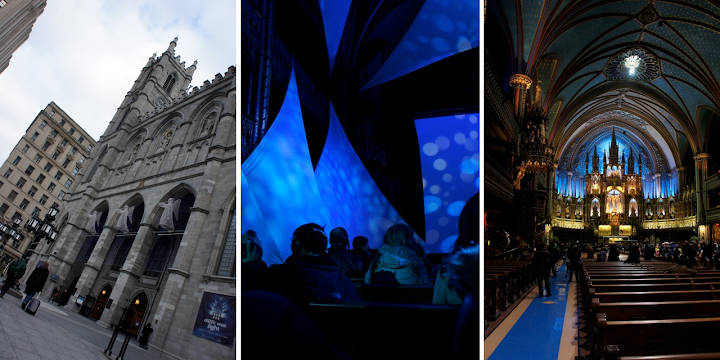
Notre Dame Basilica is set in the heart of Montreal's old town. With its twin bell towers, you could be forgiven for thinking that the name comes from its famous Parisian counter-part. You may even be right, but no one will admit to it; not wikipedia and not the Sound & Light show we attended on Saturday evening.
The flier for this event shows the church nave decked with triangular sails upon which artfully coloured blobs were projected. In a second image, the sails were gone and red and blue lights illuminated different parts of the ornately carved facades. I was therefore expecting the acoustical and elaborately designed interior of the church to be taken advantage of in an abstract interpretation of thundering music.
What I got was a history lesson. Which was somewhat of a surprise.
In 1657, the French settlement of 'Ville Marie' was founded in the new land and with it, a small chapel. The small colony faced difficult times along with their European compatriots up and down the coast but eventually it expanded enough to build a hospital and the chapel was re-housed inside it.
The colony continued to grow and finally in 1672, it got its own parish church which was given the name 'Notre Dame'. The population did not stop there and it reached the stage where thousands of the village worshippers were forced to gather outside the church's doors each Sunday. A new building was needed and an Irish architect by the name of James O'Donnell was brought in for the job. O'Donnell was residing in New York and was originally a Protestant, but converted to Catholicism on his deathbed, quite possibly so he could be buried in his own church. He lies in the crypt alone, so possibly no one else believed in his change of allegiance either. The show mentions that O'Donnell's remains lie beneath your feet, but does not mention his abrupt conversation; wikipedia being a far more reliable source for such juicy details.
O'Donnell lived to see his church open in 1829, but his death in 1830 came eleven years before the construction of its first bell tower. Until that time, the bell was rung from the old church building that was still situated in front of its replacement. While undoubtedly impressive, O'Donnell's design was flawed by his choice for lighting. Behind the alter, there was a large window whose light blinded the faithful who sat in the middle pews. The --undoubtedly more guilt ridden-- parishioners who had slunk to the side were shrouded in darkness. Feasibly no one in the congregation had a problem with this but nevertheless, the interior was redesigned between 1872-79 by Victor Bourgeau, who also designed the intricate pulpit which winds like spiral treehouse to the left of the alter. The front of the church is now covered by an elaborate wooden façade and light enters the church from stained glass side windows. From the outside, you can see an extension now backs onto that part of the church, so presumably the old window is completely bricked up. The interior is undoubtedly very impressive, even if one of my friends proclaimed the pillars to look like Christmas wrapping paper.
All of this was told to us through narration interspersed by --it must be said-- somewhat dubious and sycophantic actors. That aside, the content, which highlighted Notre Dame's history intertwined with that of Montreal's, was extremely interesting. Images of the early settlement were also shown on the sail screens and, when points about the church's architecture were discussed, lights lit the relevant part of the décor.
In 1982, Pope Jean Paul II visited Montreal and raised the status of Notre Dame to a basilica. It also was the location of Celine Dion's wedding in 1994. The show mentioned the former, but not the latter. No prizes for guessing where I got the second fact from.